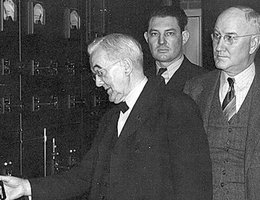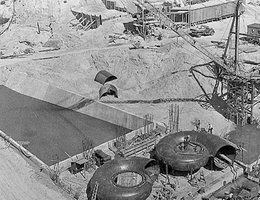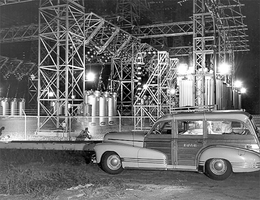

Another influential figure during the efforts to secure federal approval and funds for the project was U.S. Senator George W. Norris of McCook, Nebraska. Senator Norris played a pivotal role in guiding the project through the federal government’s bureaucratic maze. Senator Norris personally intervened on behalf of the Tri-County Project on several occasions. His efforts to convince Secretary of the Interior Harold Ickes and President Franklin Roosevelt, with whom he had a good working relationship, that the project was essential to Nebraska’s well-being eventually were successful.
Prior to the formation of the Central District, George E. Johnson played a vital role in the development of the project. Johnson promoted the project to politicians, federal agencies, and farmers from 1915 until its approval in 1935. He was the chief engineer during construction of the project and served as the Central District’s first general manager from 1935 until 1946. He played an important role in the design and development of Nebraska’s Rural Electrification Administration projects that brought electricity to the state’s farms and small towns. He also helped with the design of the Loup Public Power District’s project.
“ . . . No man is more important in the history of public power development in Nebraska than George E. Johnson. To honor his contributions to the Central District, Johnson Lake and the Johnson No. 1 and No. 2 hydroplants are named for him.” —From the book, Public Power in Nebraska

Senator Norris continued his efforts during the early 1930s to extend the benefits of electricity to all, throwing his support behind federal Public Works Administration projects that would aid rural areas and later, the Rural Electrification Act.
President Franklin D. Roosevelt also pressured the Public Works Administration to change its policies and begin providing funds for power and irrigation projects. Coupled with passage of the Rural Electrification Act in 1936, which provided funds to enable construction of generation and transmission facilities to serve rural areas, public power providers gained the upper hand in their battle against the private power companies.

Between 1933 and 1943, 16 public power districts and 35 rural electrification districts were formed in Nebraska. Some of the districts never went into operation and others concentrated solely on irrigation, but the Platte Valley Public Power and Irrigation District, the Loup River Public Power District and the Central Nebraska Public Power and Irrigation District were completed. The amount of power generated at hydroplants operated by the three districts could meet 80 to 85 percent of Nebraska’s power needs at low rates, a fact that caused the private power companies to strongly oppose creation of the districts.
However, their opposition soon crumbled. When the U.S. Supreme Court broke up the private holding companies, the stage was set for public power entities to begin acquiring the generation and transmission facilities owned by the private power companies. By 1949, all of the private companies in Nebraska had been purchased by public power systems. Nebraska became the nation’s only state to be served entirely by public power, a unique position that it still holds today.
Although Nebraska’s public power entities went through various conflicts and growing pains over the next several decades, the concept of delivering reliable electrical service to all Nebraskans at the lowest possible cost has remained the basis for public power. Today, on average, electrical rates in Nebraska are the seventh lowest in the nation.